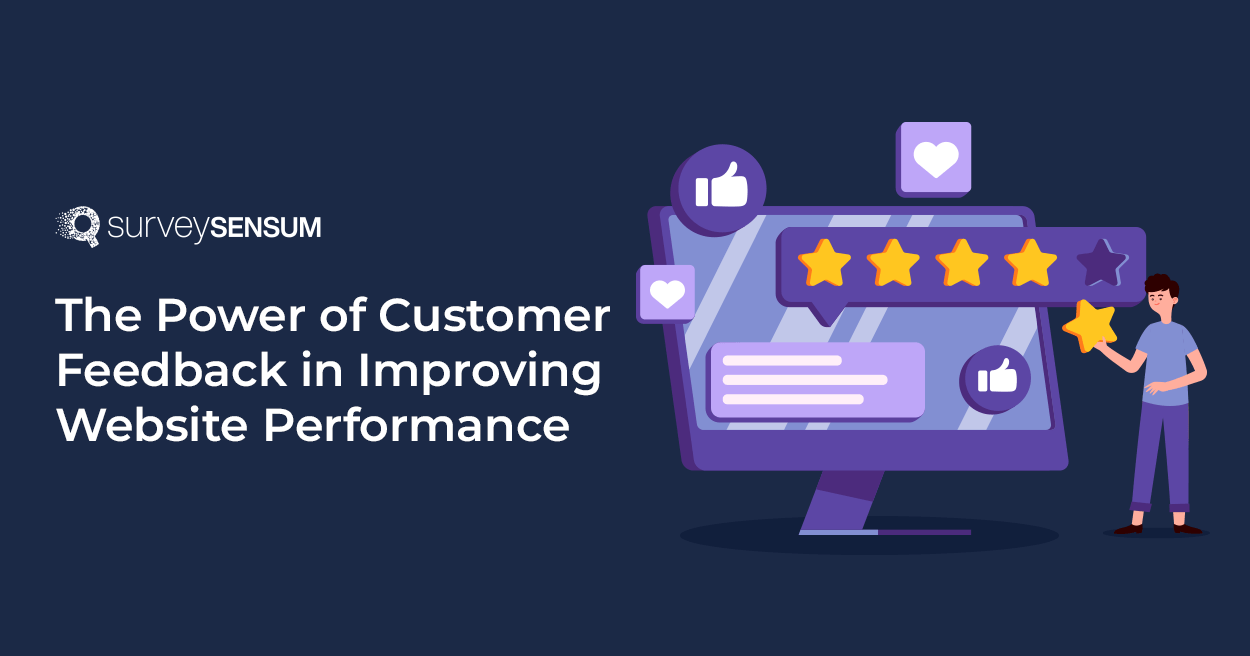9 Ways to Improve NPS Response Rates
Read More

Customer feedback is not merely a tool for gauging customer satisfaction. Instead, it’s an invaluable resource for optimizing your website’s performance.
Indulging in open dialogue with users allows you to understand what works and what needs improvement, as observed from their perspective. This user-centric approach translates into actionable insights, helping deliver better web experiences that drive business growth and increase brand loyalty.
By taking on board direct observations or suggestions from users about site speed, navigation complexity or load times, you can quickly discover any weak spots within your digital structure. This matters a lot, as a Deloitte study found that even a 0.1 second difference in page load speed can influence conversion rates by as much as 10%.
Therefore, appreciating and utilizing customer feedback effectively serves as the cornerstone for refining websites successfully. Given that a report from Microsoft found attention spans are shrinking, falling to 8 seconds from 12 seconds since the turn of the millennium, this is only going to become more relevant with each passing year.
With all that in mind, let’s look at the different areas in which this has a part to play in more detail, so you can implement such a strategy to overhaul your own site.
If visitors tell you that your site is loading slowly, you need to take action, as we’ve established. Here are some things to do in this situation:
By using feedback to guide your troubleshooting, the upshot will be that every choice you make and fork in the road you face regarding pure page speed optimization in a data-driven way. If you want to explore further ways to optimize your site’s performance, consider looking into nodejs logging for comprehensive insights into enhancing the efficiency of your web applications.
User comments are an indispensable tool for tracking your website’s reliability, and since the cost of downtime is steep, you want to make sure it stays live to serve visitors 24/7. Here are some ways they can prove instrumental:
By focusing diligently on comments directed towards the site’s stability and security, you have a direct line into consumers’ evaluation of its dependability. This enables strategic prioritizing of fixes enhancing overall user satisfaction, turning words into action.
Customer feedback, especially for a website development company, plays a pivotal role in crafting an exceptional user experience on your website. This is a cumulative aspect of what it offers, combining underlying performance with other elements like interface design. Input from visitors can help in the following ways:
Paying close attention to customer feedback means decisions concerning UX modifications are driven by genuine demand, transforming opinions into actions that foster continued visitor engagement. This cycle iteratively improves user satisfaction over time and leads to better website performance.
Negative reviews, when approached constructively, can be instrumental in bolstering your website’s performance:
Understanding negative feedback as an avenue for growth rather than a setback enables you to take decisive corrective actions. As such, augmenting your web platform’s effectiveness while building stronger relationships with users.
Positive feedback provides important insights into your website’s strengths, supporting continuous improvement. Let’s look at a few ways you can wring value from glowing reviews:
Recognizing trends in positive remarks, from site aesthetics to robust security measures, lets you identify key success drivers. Harness this knowledge to maintain outstanding attributes and preserve site performance in response.
Gather Customer Feedback with Surveys – Sign Up for Free
Neutral reviews contain valuable insights that might otherwise go unnoticed, so it’s important not to overlook them. Here are ways to get the most out of them:
Delving deep into neutral feedback gives you an opportunity to refine your website from satisfactory to exceptional, stirring emotion and creating memorable digital customer experiences.
Transforming customer feedback into strategic decisions can effectively drive more traffic to your website. Consider the following strategies in this context:
Listening closely and reacting swiftly to what customers say is a well-strategized plan which can ensure amplification in web traffic, showing how real improvement happens when action is coupled with feedback.
Nurturing relationships with users is a core component of any successful web platform. It promotes active engagement and fosters trust, transforming casual visitors into loyal followers. Here are ways you can accomplish this:
In brief, the quality of the relationship you establish with your users significantly influences their loyalty towards your online ventures.
Leveraging data from user feedback supports informed decision-making for your website’s refinement. It illuminates patterns, details specific problem areas and their potential solutions. Here are ways you can use such insightful information:
Gleaning actionable knowledge from user feedback assists in dynamic decision-making that takes into account the unique needs and preferences of your audience. The end goal is to produce a perfectly tailored online platform.
Web performance improvement is a continuous, cyclical process that thrives on the back-and-forth of user feedback. Each iteration brings about enhanced navigation experience and better engagement opportunities.
Explore these adaptations:
This iterative learning cycle, driven by consumer-powered growth and expert guidance from your UX agency, ensures you’re continually working towards a better UX, ultimately contributing to the overall success of your operations.
Ultimately, customer feedback profoundly influences every facet of your website’s performance. Nurturing a dialogue with your users not only fosters relationships but also unlocks opportunities for growth and refinement. Engaging deeply with this feedback guides you in delivering exceptional digital experiences that drive both user satisfaction and business success, so don’t sit back and ignore the opportunities it presents.
Author Bio:
Dean Fankhauser, the visionary CEO & Founder at PromptPal, has an impressive portfolio as the mastermind behind Blu.Ventures, a startup studio cultivating innovations in blue ocean industries. With notable ventures like Bitcompare, Movingto, and AITW under his belt.
